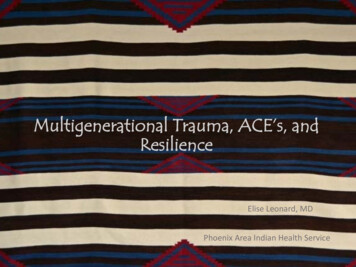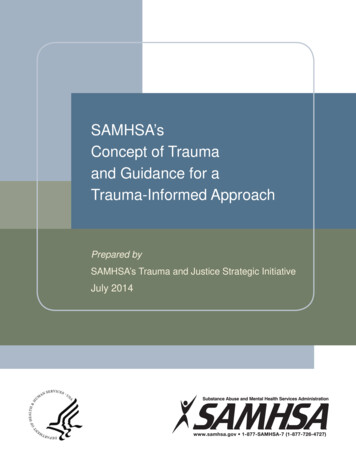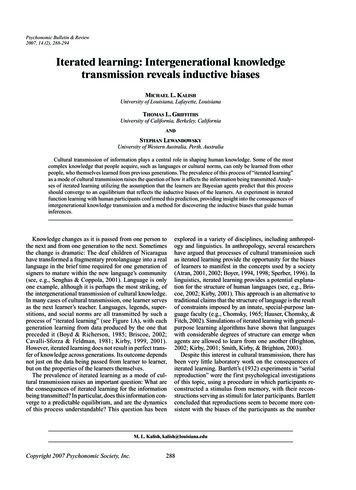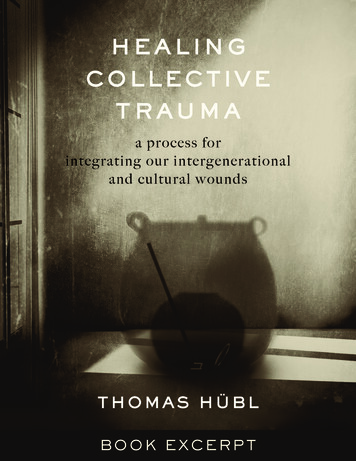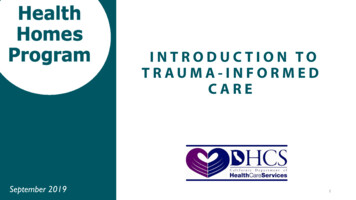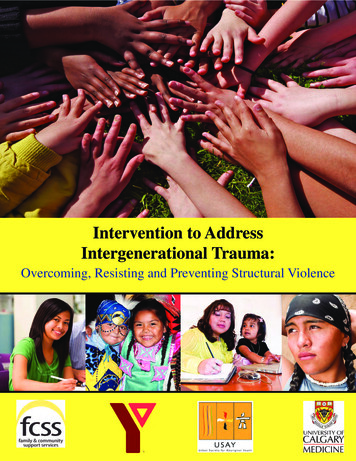
Transcription
Intervention to AddressIntergenerational Trauma:Overcoming, Resisting and Preventing Structural Violence
Winter, 2012 [INTERGENERATIONAL TRAUMA]ACKNOWLEDGEMENTSThis scoping review was a product of collaboration and partnership between theUrban Society for Aboriginal Youth, YMCA Calgary and University of Calgary, withfunding provided by the City of Calgary, Family and Community Support Services.We would like to acknowledge the following key stakeholders for their contributionto the project: Raheem Noormohamed, Research Assistant LeeAnne Ireland, Executive Director, Urban Society for Aboriginal Youth Sharon Goulet, Community Planner, Family and Community Support Services Tanis Cochrane, VP Children and Youth Strategy, YMCA Calgary Christy Daniels, General Manager, YMCA Calgary Laurie Beatt, Outcomes Coordinator, YMCA Calgary Wilfreda E. Thurston, PhD, Department of Community Health Sciences,Faculty of Medicine, University of Calgary Amrita Roy, MD-PhD student, Department of Community Health Sciences,Faculty of Medicine, University of Calgary David Turner, Research Coordinator, NEAHR-Southern Alberta, University ofCalgary Christy Morgan, Community Event Planner1
[INTERGENERATIONAL TRAUMA] Winter, 2012SECTION DESCRIPTIONSECTIONMAIN IDEABackground What is Intergenerational Trauma and how does it affect thewell-being of Aboriginal youth? The Aboriginal Healing Foundation (AHF) and the idea of“Promising Healing Practices” The AHF pillars of healing (intervention types)Interventions Intervention Type results based on academic reportRecommendations Integrating Aboriginal worldviews or culture into efforts toaddress Intergenerational Trauma in youth Using the formation of cultural identity as a healing tool Promoting Aboriginal youth groups and organizations that dealIntergenerational Trauma to be autonomous Integrating ongoing programs with mainstream health servicesand furthering overall collaborationConsultation Results Question 1: Of the recommendations that were discussed today,do you have similar practices in your agency’s programs? Question 2: How do you know what you do addressesIntergenerational Trauma? Question 3: What would your agency need to better implementand evaluate your youth programming?Discussion Incorporating Aboriginal worldviews or values in practices foryouth is a well-established concept in healing Collaboration has multiple benefits, but awareness ofAboriginal history and worldviews must be maintained Evaluation of youth program can occur in many ways Further knowledge of Intergenerational Trauma would createmore opportunities for promising practices Funding is interconnected with other recommendations andchallenges found in this reportNext Steps Reporting and evaluation must increase for practices involvingAboriginal youth Search for new evaluation methods and conduct moreevaluations Develop and share resources for educating about or addressingIntergenerational Trauma in Aboriginal youth Seek new ways of collaboration, build new partnerships andaddressing funding through connections2
Winter, 2012 [INTERGENERATIONAL TRAUMA]EXECUTIVE SUMMARYThis report discusses practices for healing the effects of intergenerational trauma inAboriginal youth. Intergenerational trauma is the transmission of historicaloppression and its negative consequences across generations. There is evidence ofthe impact of intergenerational trauma on the health and well-being and on thehealth and social disparities facing Aboriginal peoples in Canada and othercountries. The effects on children of survivors of the residential school system aredocumented, but it is unclear whether there exist specific practices which effectivelyfacilitate healing for intergenerational trauma in youth areleased a report in 2006entitled “Promising amework for facilitatinghealing for intergenerationaltrauma and also workandthecategories are helpful inunderstandingpromisingpractices in this context.This paper describes a scoping review, (see Appendix E for more details) conductedto address the question of what defines best practice for addressing the impacts onhealth of intergenerational trauma in Aboriginal youth in Canada. The purpose wasto identify recommendations for practices that can address intergenerationaltrauma in Aboriginal youth, to identify areas where more research is required tolearn more about what may work, and to hear from community members whatcould be of greatest benefit to Aboriginal youth who are affected byintergenerational trauma.Our scoping review consisted of sixteen papers or reports, describing practicesrelated to intergenerational trauma. The papers were analyzed and sorted based onthe health issue addressed, the Aboriginal Healing Foundation intervention type,and the recommendations provided. The recommendations and research gapsdiscovered in this process were presented to community members in December of2011. Facilitated discussions followed the presentation and the general themes fromthe discussions were compared to the recommendations and themes from theacademic process.3
[INTERGENERATIONAL TRAUMA] Winter, 2012The major finding of this scoping review is that the research or reporting onpractices for addressing intergenerational trauma in Aboriginal youth is minimal. Inaddition, evaluations of existing and future interventions will require morestandardized and thorough approaches. The primary recommendations establishedfrom the reviewed papers in the academic report were to: Integrate Aboriginal worldviews into interventions; Strengthen cultural identity as a healing tool; Build autonomous and self-determining Aboriginal healing organizations; To integrate existing, but isolated interventions into mainstream healthservices; and Involve mainstream professionals learning more about Aboriginalapproaches to healing.The community discussion revealed similarities to the recommendations found inthe scoping review. However, community members also felt there is a need for moreholistic evaluations, more reliable funding and more resources to access informationabout addressing intergenerational trauma.4
Winter, 2012 [INTERGENERATIONAL TRAUMA]BACKGROUNDMany Aboriginal youth in Canada, who are defined as youth from “Indian, Métis orInuit,” background in the Constitution Act of 1982, face devastating health andwellness consequences due to historical oppression. Ongoing discrimination andstereotypes that have health and wellness consequences, the effects of pastinjustices which have marginalized or collectively harmed Aboriginal peoples, havehad lasting negative affects (Sotero, 2006). In Canada, historical injustice oroppression against Aboriginal groups began with contact with European settlers. Itcontinued with the spread ofdisease that killed a large“Many Aboriginal youth in Canada facemajorityoftheNativedevastating healthy and wellnesspopulation, the stealing of land,the Indian Act of 1857 and mostconsequences due to historicalrecently the residential schooloppression.”experience, where children ofAboriginal descent were takenfrom their parents at a young age and sent to the boarding schools in order to forceassimilation and abolish Aboriginal cultures (Aboriginal Healing Foundation, 2006).In addition to the cultural loss that occurred at these schools, there were alsowidespread cases of physical, sexual and psychological abuse that traumatizedsurvivors of the school system (Smith et al., 2005; Sotero, 2006). The last residentialschool in Canada closed in 1996, and since then there has been a realization thatsurvivors of the system have a host of personal, mental and health issues thatrequire attention and intervention (Quinn, 2007).A phenomenon, labeled Intergenerational Trauma (or also known as HistoricTrauma, Collective trauma, Trans-generational grief, Historic grief) has been seen inthe descendants of Survivors who may have not experienced the trauma of abusethemselves (BraveHeart and Debeurn, 1998; Quinn, 2007). A definition ofintergenerational trauma can be found in Evans-Campbell(2008):“A collective complex trauma inflicted on a group of people whoshare a specific group identity or affiliation—ethnicity, nationality,and religious affiliation. It is the legacy of numerous traumaticevents a community experiences over generations andencompasses the psychological and social responses to suchevents.”(p.320)5
[INTERGENERATIONAL TRAUMA] Winter, 2012Intergenerational trauma can seem complicated and academics have developedsophisticated modes to explain how it works. However there has been less of aneffort to develop models of healing intergenerational trauma. It is acknowledgedthat the cumulative effects of trauma are passed down along generations and oftenare amplified or cause other unpredictable impacts.With this in mind it can be understood why the residential school experience couldhave traumatic effects in the lives of children and grandchildren of Survivors. Inaddition, the effects of oppression and trauma on individuals can result inmaladaptive parenting that can cause challenges for children (BraveHeart, 2003).Ongoing attitudes of bigotry or discrimination towards Aboriginals, including at apolicy or government level can amplify the existing effects of intergenerationaltrauma. (Wesley-Esquimaux and Smolewski, 2004; BraveHeart, 2003; Whitbeck etal., 2004; Sotero 2006). Aboriginal people have unique histories and have haddifferent aspects of trauma affect their lives, so it is not certain how prevalentintergenerational trauma is, but it is certainly a factor that affects the lives of asignificant number of young Aboriginal people in Canada.Negative outcomes of intergenerational trauma in Aboriginal peoples have beenidentified. For instance, establishing links between cultural discontinuity and mentalhealth and violence in First Nations groups in Canada (Kirmayer et al., 2000). Theresponse between historic trauma and substance abuse has been establishedthrough evidence that relatives oftraumaSurvivorsdevelopsymptoms of Post-Traumatic “It is acknowledged that the cumulativeStress Disorder and may abuse effects of trauma are passed down alongsubstances (BraveHeart, 2003).Intergenerational trauma, cultural generations and often are amplified oralienation and ongoing depression cause other unpredictable impacts. Ongoingwere found among a sample of attitudes of bigotry or discriminationhomelessAboriginalmen towards Aboriginals, including at a policy or(Menzies, 1999). In youth, ideas of government level, can intensify the existinghopelessnesscomingfrom effects of intergenerational trauma.”cultural alienation from parentswere seen as a factor contributingto suicide (Strickland et al., 2006).In addition, studies have linked Hepatitis C and HIV/AIDS in youth to historicaltrauma and experiences of sexual abuse (Pearce et al., 2008; Craib et al., 2009). On alarger scale, health statistics of Aboriginal youth in Canada show many challenges aswell (Cook and Guimond, 2008; Latimer and Foss, 2004; Chouinard et al., 2010;Health Canada, 2009). Research and advocacy by multiple researchers andstakeholders have increased awareness of the impact and intergenerationalconsequences of the residential school experience (among other events and policies)on Aboriginal communities, and have linked these ideas to a range of healthconsequences (AHF, 2006).6
Winter, 2012 [INTERGENERATIONAL TRAUMA]To understand healing in a Canadian Aboriginal context, a definition for healingprovided by the Royal Commission on Aboriginal Peoples, states that Healing is:“Personal and societal recovery from the lasting effects ofoppression and systemic racism experienced over generations.Many Aboriginal people are suffering not simply from specificdiseases and social problems, but also from a depression of spiritresulting from 200 or more years of damage to their cultures,languages, identities and self-respect. The idea of healing suggeststhat to reach “whole health,” Aboriginal people must confront thecrippling injuries of the past.”7
[INTERGENERATIONAL TRAUMA] Winter, 2012ABORIGINAL HEALING FOUNDATION AND “PROMISING HEALINGPRACTICES”The Aboriginal Healing Foundation was set-up 1998 as part of the broader healingeffort for Survivors of the Residential School System and their descendants. Itsmission is:“To provide resources which will promote reconciliation andencourage and support Aboriginal people and their communitiesin building and reinforcing sustainable healing processes thataddress the legacy of physical, sexual, mental, cultural, andspiritual abuses in the residential school system, includingintergenerational impacts.”Their work is very relevant, and we used many of their tools and ideas as afoundation for our research. In 2006 they released a report entitled, “PromisingHealing Practices.” This report introduced the idea of “Promising Healing Practices,”in place of “Best Practice”. They defined “Promising Practices” as, “Models,approaches, techniques and initiatives that are based on Aboriginal experiences;that feel right to Survivors and their families; and that result in positive changes inpeople’s lives.”(p.7)It is a more inclusive approach to healing from intergenerational trauma. TheAboriginal Healing Foundation definition will guide us in reviewing other practicesfound during the scoping review.ABORIGINAL HEALING FOUNDATION - PILLARS OF HEALINGThe Pillars of Healing as identified by the Aboriginal Healing Foundation are: Legacy Education; Cultural Interventions; and Therapeutic Interventions.These are categories of interventions based on the type of techniques used in theprogram and the desired goal of the program.LEGACY EDUCATIONLegacy Education seeks to raise awareness of the residential school (or othertraumatic) experiences and consequences. This is beneficial because it builds anunderstanding of shared experiences, allows responses to trauma to be seen as aresult of external forces, allows children to better understand the situation of theirparents and generally uses awareness to facilitate understanding which in turn canmotivate survivors and youth to pursue healing. It often involves just teaching youthabout the past.8
Winter, 2012 [INTERGENERATIONAL TRAUMA]CULTURAL INTERVENTIONSCultural interventions work by infusing cultural awareness and teaching as theprimary goal of interventions. Cultural activities are the keystone of theseinterventions. This category can include any type of cultural activity beyond alreadyrecognized healing ceremonies as an intervention. These interventions are meant tomold and reinforce identity, so as to facilitate the healing process.THERAPEUTIC INTERVENTIONSThese deal directly with a specific outcome such as a health issue. The AboriginalHealing Foundation report mentionswestern, traditional, and combinedtherapeutic approaches in thiscategory.Westernapproachesgenerally favor medical models ofdisease that look at the individuallevel and act to alleviate sufferingthrough physical means, althoughother forms of social work are part ofthis category. Traditional therapies aregenerally more holistic and view theindividual as a part of culture and theenvironment.Thesetherapeuticapproaches are rooted in Aboriginalworldviews and have many possiblevariations. Approaches may includetraditional practices, such as sweat lodges, pipe ceremonies or healing circles.Combined therapies attempt to effectively integrate Western and traditionalapproaches to healing by using traditional components in medical therapies or usingWestern models in a traditional setting.SCOPING REVIEW RESULTSIn an ideal situation, these interventions would all be available to youth in the orderlisted above. Since many programs might only fit one category, the scoping reviewpapers were sorted according to the category they best fit.INTERVENTION RESULTSOverall, the results of the various interventions are as follows: 1 practice fit under the label of Legacy Education; 4 were Cultural Interventions; 10 were Therapeutic Interventions; and 2 were described as other because they were not easily identifiable in any ofthese categories, but they did attempt to address an outcome related tointergenerational trauma in Aboriginal Youth.9
[INTERGENERATIONAL TRAUMA] Winter, 2012Of the 10 Therapeutic Interventions, 2 were traditional therapeutic interventions, 3were western interventions and 5 were seen as combined or blended therapeuticinterventions. One of the traditional therapeutic interventions was also described asa cultural intervention because it combined multiple activities and programs withinthe broader intervention. It sought to address problems of HIV/AIDS in youth.LEGACY EDUCATION APPROACHThis approach described a youth suicide prevention strategy that was piloted in NewZealand. The strategy for Maori youth in New Zealand hoped to explain high levels ofsuicide within the proper colonial, historical reality that affected the Maoripopulation in order to re-form the existing strategies which treated suicide as anindividual problem (Aho and Liu, 2010).CULTURAL INTERVENTIONS APPROACHFor cultural interventions, these generally appear to either take the form oftraditional excursions, community or large-scale gatherings or programs whichintroduce youth to the practice of traditional diets, special ceremonies or othersimilar ideas. One program, known as the Midwinter Harvest Food Program inOntario, encouraged youth to learn how to prepare foods traditionally and also todistribute food to others in their community and the homeless. In addition, a center,established for this program, became a meeting place for cultural activities and apolitically active youth council (Shantz, 2010).Another cultural intervention, the Yiriman Project, in Western Australia, used theconcept of exchange between generations in place of focusing on the negativetransfer of trauma through time (Palmer et al., 2006). This emphasized the potentialof Elders and other leaders to transmit traditions through guided interaction.Activities occurred during two week long trips, where both traditional ceremoniesand practices were taught to youth. The trips allowed youth to take part in otherpositive activities, such as assisting with government research or helping withconservation efforts.Both of these cultural interventions aimed to personally connect youth with theirculture. The Aboriginal Healing Foundation identified traditional knowledge,language, traditional foods and a connection to the land, as vital to culturalinterventions, and at least one of these themes was present in each culturalintervention (AHF, 2006).THERAPEUTIC INTERVENTIONS APPROACHThese were focused on a single issue and the goal was to heal directly. Most commonwere substance abuse and some mental health issues. One combined-therapeuticintervention seeking to address alcohol use adopted a program used in schools andmodified it specifically for Cherokee youth. A 10-step program that addressedalcohol use in students was modified to include a talking-circle and notions of selfreliance, which are important to the Cherokee community, was woven into some ofthe sessions (Lowe, 2006).10
Winter, 2012 [INTERGENERATIONAL TRAUMA]Another promising combined therapeutic intervention involved the use of theCognitive Behavioral Intervention for Trauma in Schools (CBITS). This interventionwas modified for use in an American Indian community and was found by theauthors to be best practice for addressing Post Traumatic Stress Disorder anddepressive symptoms for ethnically diverse youth. It was modified by reframingsome of the sessions used in the interventions around topics of historical injustice,traditional history and coping through identification with their community. Parentswere also involved in the intervention. While this example was somewhat Western,the authors explicitly aimed to address Post Traumatic Stress Disorder from anAmerican Indian context and wanted the intervention to be seen as a syntheticprocess (Goodkind et al., 2010). Other Western and Traditional therapeutic practicesseemed promising; however, it is combined approaches that were most common inthe scoping review.11
[INTERGENERATIONAL TRAUMA] Winter, 2012RECOMMENDATIONS FROM THE SCOPING REVIEWRecommendations made by each author were collected and compared. There were fourcommon recommendations:RECOMMENDATION #1 - INTEGRATING ABORIGINAL WORLDVIEWS OR “CULTURE” INTO EFFORTS TOADDRESS INTERGENERATIONAL TRAUMA IN YOUTHSix papers recommended that Aboriginal worldviews and ideas of holistic interventionsthat integrate community and culture must be a part of any intervention. Some of thepractices that were cultural interventions, such as those using excursions with Elders tolearn more about traditional ways of life, were entirely built around Aboriginalworldviews. However, other papers explained that when they used an interventionmethod that may have been less traditional, ideas of holism and inter-connectedness tocommunity and family were emphasized in the intervention. For example, certain reportsclaimed that promoting self-reliance and personal empowerment are part of Aboriginalideas of healing and must therefore fit into the intervention. One author brought up theidea of “Cultural Relevance,” as important for those interventions that borrow heavilyfrom Western or other practices. This may or may not count as using an Aboriginalworldview in a program, but at least one author felt that it did.Aboriginal worldviews are diverse and no simple explanation of what they are exists.They may depend on geography, history, culture and much more, but it can be said thatthey do represent another element to consider when discussing healing. Since theAboriginal Healing Foundation chose to outline this same concept as important to healinginitiatives, their ideas of Aboriginal worldviews and values could further ourunderstanding. The Aboriginal Healing Foundation (2006) describes important values toconsider in healing initiatives as, “Values of wholeness, balance, harmony, relationship,connection to the land and environment, and a view of healing as a process and lifelongjourney” (p. 34).RECOMMENDATION #2 - USING THE FORMATION OF CULTURAL IDENTITY AS A HEALING TOOLStrengthening cultural identity can help facilitate the healing process. Youth positiveidentity can reduce the stigma of some issues or allow youth to feel re-connected to theirculture from which the may feel removed (Aho and Liu, 2010). In the recommendationsmade by papers, identity was seen as a tool for building self-reliance and encouragingpolitical engagement. According to some authors, identity must be framed as a dynamicpersonal commitment to tradition that takes into account circumstances of the present andthe past. Other findings reveal that youth well-being in response to intergenerationaltrauma can be facilitated by empowering cultural identities (Taylor and Usborne, 2010).Also, cultural continuity combined with community empowerment initiatives, has beenfound to be a protective factor against suicide in Aboriginal youth (Chandler andLalonde, 2008).12
Winter, 2012 [INTERGENERATIONAL TRAUMA]RECOMMENDATION # 3 - PROMOTING ABORIGINAL YOUTH GROUPS AND ORGANIZATIONS THAT DEALWITH INTERGENERATIONAL TRAUMA TO BE AUTONOMOUSTwo papers identified the need for youth groups to be agents of political advocacy. Youthgroups have the ability to build resiliency and empower youth to combat ongoingdiscrimination and to advocate for more necessary attention and resources fromgovernment and others. Self-determining youth groups often could best identify needs forother in the communities who may be affected by intergenerational trauma (Shantz,2010). This theme of autonomy is also recommended by others who believe that withoutit other institutions or agencies that serve Aboriginal youth can prevent the use of culturalideas of healing in programs (Smith et al., 2005; AHF, 2006).RECOMMENDATION #4 - INTEGRATING ONGOING PROGRAMS WITH MAINSTREAM HEALTH SERVICESAND FURTHERING OVERALL COLLABORATIONCollaboration and connections with other health or social services would allow forgreater access to funding, treatment, or research capacity, especially in more rural, remoteareas. It was also emphasized that mainstream health agencies and staff must learn moreabout Aboriginal worldviews and ways of healing. Additionally, there needs to be greaterknowledge of intergenerational trauma among workers. Some authors recommended thattheir specific intervention be adopted (but modified if necessary) by larger healthagencies or government bodies, in order to serve large communities.One example of collaboration was on a project that sought to deal with rehabilitation forAboriginal youth who had committed crimes. A group of University faculty teamed upwith existing youth-serving agencies to profile and to evaluate what work was beingcarried out (Lafreniere, 2006).Collaboration with mainstream health services should not interfere with organizationautonomy and, it is important to note that there should be a balance between them.13
[INTERGENERATIONAL TRAUMA] Winter, 2012COMMUNITY DISCUSSIONThe questions posed to community members after the presentation of the academicfindings were: Of the recommendations that were discussed today, do you have similar practicesin your agency’s programs? (Please see last section for recommendations). How do you know what you do is effective in addressing intergenerationaltrauma? What would your agency need to better implement and evaluate your youthprogramming?Analysis of the discussion group conversations showed some common themes that arepresented on the following pages. Appendix C lists a table of common themes.THEME #1 - PRACTICES OR PROGRAMS THAT INCORPORATE OR USE ABORIGINAL WORLDVIEWS INSOME WAY IN ADDITION TO ATTEMPTS TO STRENGTHEN YOUTH IDENTITYConversations revolved ity members often feltthat their programs, includingthose that may not haveaddressedintergenerationaltrauma explicitly, includedsome element of Aboriginalvalues or culture or wereholistic. Program participantsview the programs as placeswhere cultural identity isexplored and strengthened.The idea of incorporatingAboriginal worldviews meansmany things, but examplesincluded using traditionalactivities for healing history into programs, andusing holistic language.One Aboriginal participantexplained their approach in aspecific program:14
Winter, 2012 [INTERGENERATIONAL TRAUMA]“[Our program] focuses on Aboriginal learning styles, specific to theirneeds in learning. How do we help them reconnect to their culturewhich was a huge issue for many of them and so we look at each ofthe barriers that were preventing them from engaging in the successesin education and employment and then tried to use research-basedinformation for curriculum development that was specific toAboriginal learning styles.”The discussions reflected the academic theme of incorporating cultural elements intoprograms. This overlapped with the idea discussed by some respondents about havingstaff trained in Aboriginal awareness or hiring Aboriginal staff. Some responses outlinedthat staff had undergone competency training to work with Aboriginal people invulnerable settings while others stressed the importance of hiring Aboriginal staff to workwith youth. This broadly related to the academic recommendation of having mainstreamprofessionals be trained further in the history and values of the people they work with andthe programs and services they deliver.THEME #2 - COLLABORATIONS OR CONNECTIONS TO OTHER GROUPS OCCURS IN PROGRAMS FOR AVARIETY OF REASONSThe other common recommendation shared by community members was collaboration.The general theme of working with other partners, whether by other youth agencies,government or academics, was discussed by some groups. The purposes of collaborationcertainly varies; some community members spoke of it as a means to learn more aboutAboriginal youth, while others talked about it for research purposes.THEME #3 - ORAL FEEDBACK OR SIMILAR FORMS OF REFLECTION AND NARRATIVE FORMATION AREA KEY PART OF PROGRAM EVALUATIONSTalk of assessment generated many diverse responses and all types of relaxed or informaltypes of evaluation were brought up as well as more research-oriented methods. Oralfeedback from participants was the most common form of evaluation. This meant thatconversations, interviews, stories or other methods of assessment were important. Thenotion that conversations are practical for evaluation was seen to be valid by some onlywhen there was a safe, trusting environment.One respondent stated:“The students feel safe when they come to our center. That’s how Iknow we’re doing a good job when they feel that they’re comfortableto say what they need to say whether they have a criticism of what’shappening at the Lodge or whether they have something very heavyon their hearts; it’s safe for them to share it.”Oral feedback can also be combined with other measures of success. This responseillustrates this concept:15
[INTERGENERATIONAL TRAUMA] Winter, 2012“Every morning [the youth] have a sharing circle and, [we ask] howwas your night, what went on, say for example one of the youth had afight with their Mom or their boyfriend; you know then they’re askedwell how did you address it, how did you deal with it, did you applyyour life skills in that situation right and so they’re asked those typesof questions and the youth are pretty honest.”THEME #4 - COMMITMENT TO PROGRAMS OR UPKEEP OF ATTENDANCE BY YOUTH AS WELL ASPROGRAM GROWTH IS INDICATORS OF SUCCESSMany respondents outlined that they felt ongoing participation and/or completion ofprogr
The Aboriginal Healing Foundation (AHF) and the idea of "Promising Healing Practices" The AHF pillars of healing (intervention types) Interventions Intervention Type results based on academic report Recommendations Integrating Aboriginal worldviews or culture into efforts to address Intergenerational Trauma in youth

